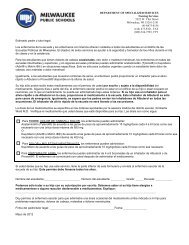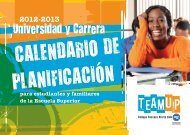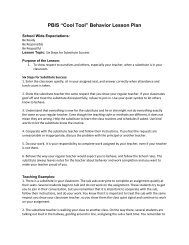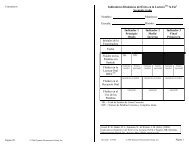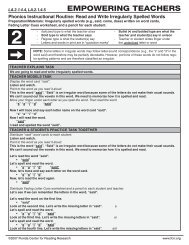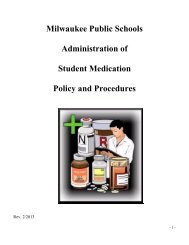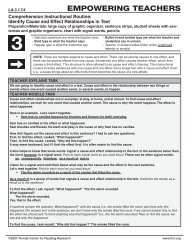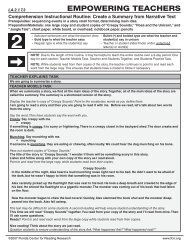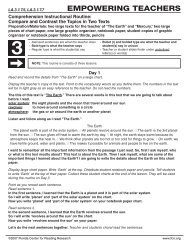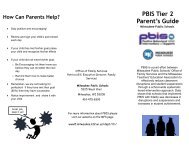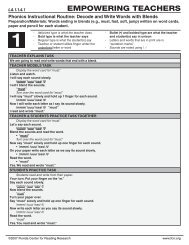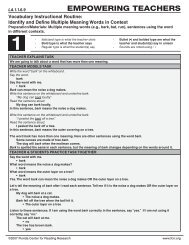Tiers 2 and 3 Intervention Entrance and Exit Criteria Quick ...
Tiers 2 and 3 Intervention Entrance and Exit Criteria Quick ...
Tiers 2 and 3 Intervention Entrance and Exit Criteria Quick ...
Create successful ePaper yourself
Turn your PDF publications into a flip-book with our unique Google optimized e-Paper software.
<strong>Tiers</strong> 2 <strong>and</strong> 3 <strong>Intervention</strong> <strong>Entrance</strong> <strong>and</strong> <strong>Exit</strong> <strong>Criteria</strong><br />
<strong>Quick</strong> Reference for Struggling Learners<br />
Tier 2 <strong>Entrance</strong> <strong>Criteria</strong><br />
1. Using the ClasStat process, analyze data from<br />
most current Universal Screener (MAP/MPG,<br />
IDEL, SAIL) to identify students who are the<br />
lowest 20% at each grade level using the School<br />
Dashboard report titled: Universal Screener:<br />
Current Student Detail, <strong>and</strong> if needed, NWEA<br />
report by grade report<br />
2. Using the ClasStat process to triangulate most<br />
current summative <strong>and</strong> formative data (including<br />
attendance, incident <strong>and</strong> suspension data when<br />
appropriate) to determine if the students in the<br />
lowest 20% are:<br />
performing at or above proficiency for<br />
grade according to the most current<br />
screener; or<br />
receiving specialized support in the<br />
identified area of concern through<br />
additional instruction provided by a<br />
special education teacher (i.e., a reading<br />
<strong>and</strong>/or math page in the IEP) or receiving<br />
a “double dose” or supplemental course<br />
in reading <strong>and</strong>/or math or receiving a<br />
replacement curriculum (e.g., Unique or<br />
Language!))<br />
below proficient, but based on growth,<br />
evidenced by formative data, are<br />
appropriately responding to core<br />
instruction.<br />
in need of a behavioral intervention prior<br />
to attempting an academic intervention<br />
Students meeting the above criteria are<br />
placed in an observation group with a<br />
focus on differentiation at the core, with a<br />
note to indicate why they are not receiving<br />
Tier 2 at this time. Students’ progress is<br />
observed <strong>and</strong> notes are recorded monthly.<br />
3. The instructional needs of the remaining<br />
students of the identified 20% are then planned for<br />
<strong>and</strong> supported by:<br />
Identify the area/s of concern(AOC) for<br />
each student this might include academic<br />
-through survey level assessment* <strong>and</strong>/or<br />
behavioral where appropriateIdentify<br />
which skills within AOC need<br />
intervention based on diagnostic<br />
assessment or error analysis *<br />
Organize instructional intervention<br />
groups based on identified areas of<br />
concern (AOC).<br />
Schedule intervention groups<br />
(<strong>Intervention</strong> time is to built into all<br />
school schedules)<br />
Determine who will deliver interventions<br />
<strong>and</strong> conduct progress monitoring.<br />
Determine who will be in charge of data<br />
management:<br />
o Is progress monitoring<br />
o<br />
happening?<br />
Is data being entered into<br />
Exceed?<br />
Select evidence based<br />
intervention/strategy <strong>and</strong> gather materials<br />
Set the baseline score <strong>and</strong> appropriate<br />
target score using survey level<br />
assessment data* with benchmark goals<br />
<strong>and</strong> goal setting guidance (in Reading: see<br />
RtI H<strong>and</strong>book-Appendix C, DIBELS<br />
Next or IDEL Benchmark Goals) (in<br />
math: see easyCBM)<br />
Develop individual intervention plans for<br />
each student in EXCEED RtI.<br />
Provide intervention to students according<br />
to the recorded plan<br />
*Use Survey Level Assessment (see h<strong>and</strong>book for<br />
specific description)<br />
4. For students who receive daily intervention,<br />
their progress monitoring occurs weekly. Teachers<br />
record <strong>and</strong> plot data scores on the progress<br />
monitoring booklets <strong>and</strong> enter scores into<br />
EXCEED®RtI respectively. The graph generated<br />
by the intervention plan <strong>and</strong> progress monitoring<br />
data points in EXCEED will be used to apply the<br />
decision-making rules after 3 scores have been<br />
recorded. These data points guide<br />
the team’s discussion to:<br />
determine the rate of a student's progress;<br />
provide information on the effectiveness<br />
of instruction <strong>and</strong> need for modification of<br />
the intervention, <strong>and</strong> if necessary;<br />
identify the need for additional<br />
information, analyze <strong>and</strong> interpret gaps<br />
between aimline <strong>and</strong> achievement.<br />
If student/s demonstrate success with an<br />
intervention:<br />
Increase the target goal <strong>and</strong> continue the<br />
current intervention<br />
<strong>Exit</strong> students from Tier 2 interventions<br />
who have made sufficient progress as<br />
determined by grade level expectations on
<strong>Tiers</strong> 2 <strong>and</strong> 3 <strong>Intervention</strong> <strong>Entrance</strong> <strong>and</strong> <strong>Exit</strong> <strong>Criteria</strong><br />
<strong>Quick</strong> Reference for Struggling Learners<br />
DIBELS Next or IDEL probes <strong>and</strong>/or the<br />
Math easyCBM tools<br />
Provide a new intervention to target the<br />
next skill level needed to become<br />
successful in Tier 1.<br />
8. Students who are exited from Tier 2<br />
intervention should be monitored for progress to<br />
ensure that they can maintain the skill level<br />
without the previously provided support.<br />
Tier 2 <strong>Intervention</strong> Progress <strong>and</strong> <strong>Exit</strong><br />
<strong>Criteria</strong><br />
1. During the intervention process, a data-driven<br />
decision must be made about the student’s<br />
instructional needs. Examine the last 3 consecutive<br />
scores to determine instructional success of the<br />
intervention. If student/s demonstrate success with<br />
an intervention:<br />
Increase the target goal <strong>and</strong> continue the<br />
current intervention<br />
Provide a new intervention to target the<br />
next skill level needed to become<br />
successful in Tier 1.<br />
<strong>Exit</strong> students from Tier 2 interventions<br />
who have made sufficient progress as<br />
determined by grade level expectations on<br />
progress monitoring probes<br />
2. If student/s are not making expected progress,<br />
make a change to one of the following:<br />
Check to confirm the Area of Concern<br />
(AOC) is correct<br />
Check the fidelity of the instruction for the<br />
selected intervention<br />
Check if the intervention target was set<br />
appropriately<br />
Adjust the Intensity of the<br />
intervention:<br />
o Increase the number of times or<br />
the length of time the student<br />
receives the selected intervention<br />
o Select a different intervention<br />
that ensures alignment with the<br />
skill deficit<br />
o Move the student to a different<br />
intervention group or if<br />
necessary;<br />
o Initiate a Tier 3 intervention<br />
request<br />
Adjust the pacing of the instruction if all three<br />
scores fall above the aimline. If all three scores are<br />
on or<br />
near the aimline continue to collect data for the<br />
remainder of the intervention until the 3 point rule<br />
can be applied or end of year target for skill is met.<br />
Tier 3 <strong>Entrance</strong> <strong>Criteria</strong><br />
1. Tier 2 interventions have not proven to be<br />
effective based on progress monitoring data,<br />
universal screener data <strong>and</strong> other classroom<br />
formative data.<br />
2. Student is at least 2 years delayed according to<br />
grade level benchmark goals.<br />
3. The Tier 3 Team will gather additional<br />
diagnostic assessments to determine specific<br />
need/s for intervention.<br />
4. <strong>Intervention</strong> will take place at least 20-30<br />
minutes daily in addition to required core<br />
instruction time*. (Exception will be a replacement<br />
curriculum for 90 minutes a day).<br />
5. Group size will not exceed 3 students (with the<br />
exception being a replacement curriculum groupe.g.,<br />
Language!).<br />
6. If student continues to demonstrate a lack of<br />
expected progress after 6 weeks of daily<br />
intervention, the next step could include a request<br />
for a special education evaluation.<br />
*Regular Education teachers are responsible for<br />
providing intensive interventions to students who<br />
are being referred for an initial special education<br />
evaluation.<br />
Tier 3 <strong>Exit</strong> <strong>Criteria</strong><br />
1. The student demonstrates expected growth<br />
based on benchmark grade level data.<br />
The student returns to a Tier 2<br />
intervention group to ensure continued<br />
skill development until Tier 2 exit criteria<br />
is met.<br />
2. Student was referred for a special education<br />
evaluation <strong>and</strong> qualified for services.<br />
Upon qualifying for special education<br />
services within the area of concern, the<br />
delivery of the intervention (when<br />
successful) will transition to the special<br />
education teacher.



